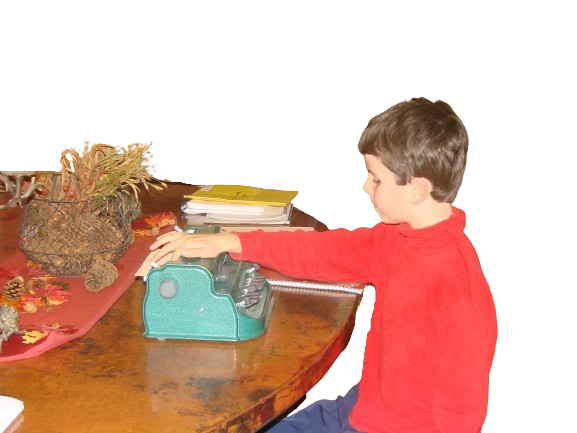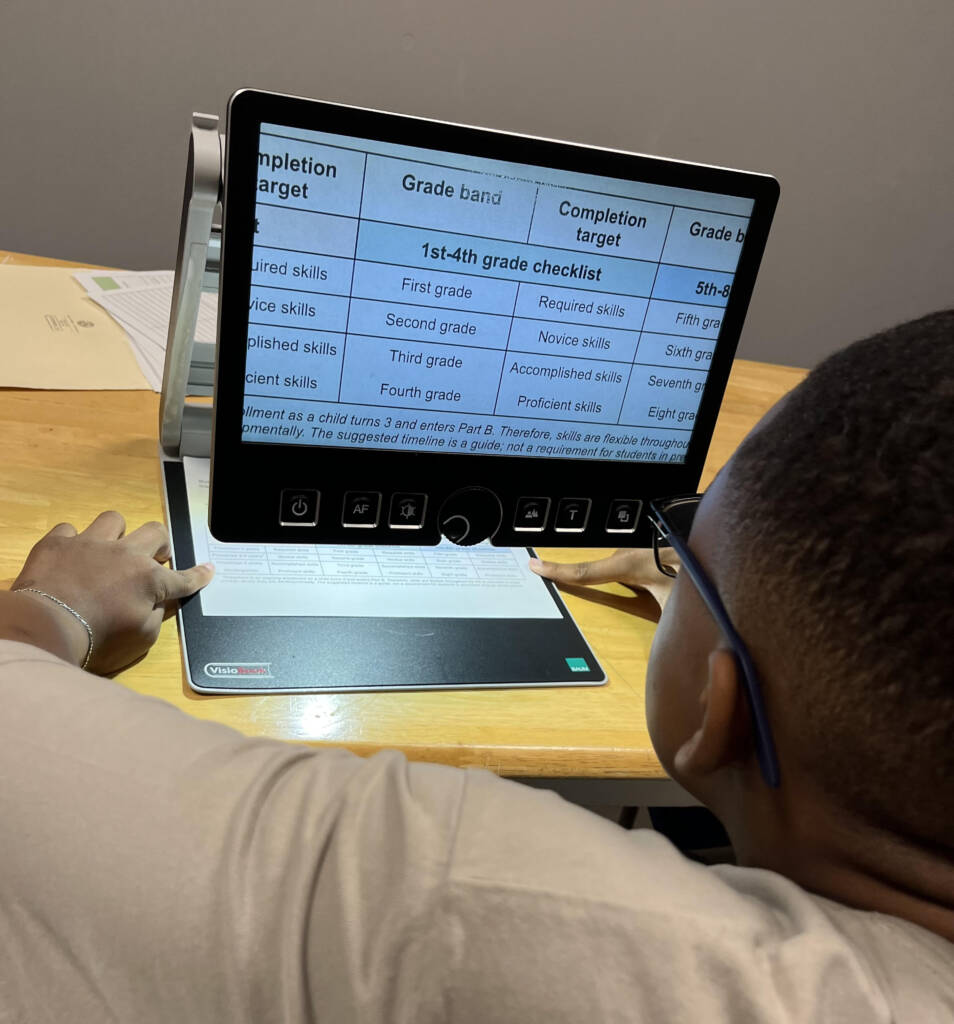“Visual learners” refers to individuals who access materials and the environment through the visual channel. This includes print readers, as well as those who use pictures and other visual materials. Some students will use their vision for specific tasks, and may use tactile or audio materials as well (dual media learners, see below). The primary and secondary instructional media is typically determined through a Learning Media Assessment (LMA).
Children with brain-based visual impairment (CVI) may be visual learners. For more information about cortical/cerebral visual impairment, please see the section on CVI.

What does it mean to have “low vision”?
Students with a visual impairment or low vision may have many different types of vision loss, and their ability to use their residual or remaining vision will vary from one student to the next. Definitions of low vision vary. Some states use a specific acuity or field loss to determine whether or not an individual has “low vision”, while other states look at an individual’s functional abilities and whether or not vision interferes with their ability to perform a task. One common definition of low vision is visual acuity measuring 20/70 or worse in the best eye after correction. This means that when they are wearing their glasses, they are able to see at 20 feet what an average person can see at 70 feet using their better eye. A visual field loss is another type of low vision, meaning the ability to see straight ahead, to the left and right, and up and down in a continuous way is affected. A field loss may be peripheral or to the sides, or it may be central or straight ahead. The specific type of loss will be important to observe and measure in order to determine optimal conditions for the student’s educational program.
How is eligibility for services determined?
A 2017 letter from OSERS (Office of Special Education and Rehabilitation Services) states that “any impairment in vision, regardless of significance or severity, must be included in a State’s definition, provided that such impairment, even with correction, adversely affects a child’s educational performance. States may not use criteria or other definitions for “visual impairment including blindness” that result in the exclusion of children who otherwise meet the definition in 34 CFR §300.8(c)(13).“ The educational team must use a variety of assessment tools and strategies to determine eligibility.
Note that certain environmental conditions may affect the student’s performance. Lighting, contrast, and complexity may all make a difference to an individual’s ability to function visually.
See also:
- Blindness and vision impairment (World Health Organization)
- Low Vision (Cleveland Clinic)
What is a progressive vision loss?
Some children have a medical condition or type of eye disease that will result in a future loss of vision, either quickly or gradually. Conditions such as retinitis pigmentosa and glaucoma typically indicate progressive vision loss, for example. It is important to monitor vision especially closely in anyone with a progressive vision loss to determine how it is changing and how it affects an individual’s functional use of vision. While all students should have a Functional Vision Assessment (FVA) regularly, in cases where there is a progressive vision loss, the team should do the FVA and Learning Media Assessment (LMA) more often to determine whether there is a change in the student’s learning medium (e.g. from print to braille). See Dual Media for more information.
Do students with progressive visual impairments qualify for VI services?
To determine eligibility for special education services as a student with visual impairment, a school district must use a variety of assessment tools and strategies to gather functional, developmental, and academic information. Evaluations should consider a child’s future needs, so current vision status should not necessarily determine whether special education and related services are needed while in school. See the 2017 letter from OSERS (Office of Special Education and Rehabilitation Services) to learn more.
When a student has a diagnosis of a progressive visual loss, close observation and ongoing team discussion on appropriate instructional strategies is important to determine whether there is a need for VI services. There may be questions about current and future needs for more tactile literacy, such as braille, how to discuss vision changes with the student, and when (or if) to introduce more intense blindness-related skill training by a TVI or COMS.
Does it matter how old someone is when the progressive vision loss is identified?
It is also important to look at the age of a child or other individual when a progressive vision loss is identified, and whether or not they are already reading print. If a print reader loses vision later in life (i.e. after they are already fluent print readers), then the instructional strategies will be different from a progressive vision loss identified at birth.
How do I determine the needs of a student with low vision?
All children who are blind or visually impaired should have a Functional Vision Assessment to determine how much vision they have and how they use their vision, and a Learning Media Assessment to determine what type of learning media is the most appropriate. This may be large print or braille or a combination (dual media), as well as auditory or tactile media. Every learning environment should be evaluated, as conditions can vary significantly from the classroom to the gym to the library, all of which will impact the student’s ability to access information. In addition, it is important to evaluate the child at home, in the community (e.g. shopping malls, neighborhood streets) and to look at both familiar and unfamiliar locations. Lighting conditions can also affect visual functioning, so a child should be evaluated in the daytime, as well as in the evening. These assessments are done by a teacher of students with visual impairment (TVI) in collaboration with an orientation and mobility specialist (COMS) and with the family and other members of the team.
What is a Low Vision Specialist?
A low vision specialist is an eye medical professional who is trained in the management of patients with visual impairments. Low vision specialists may be optometrists or ophthalmologists with specialized training. These medical professionals use a range of assessments to evaluate visual functioning beyond what is used in a typical eye exam. Low vision specialists help patients to use their vision more effectively and/or efficiently, often by prescribing appropriate low vision devices. It is recommended that all students with visual impairment be evaluated by a low vision specialist, especially if there has been a change in vision or educational environments/materials. See also What to Expect from a Low Vision Specialist.
Additional Resources
- Low Vision in Children, Family Connect
- Low Vision Specialist, Teaching Students with Visual Impairments
- Pediatric Low Vision, American Association for Pediatric Ophthalmology & Strabismus
- Vision Classifications, Teaching Students with Visual Impairments
- Vision Impairment Among Children, CDC (Center for Disease Control)
- What is Childhood Low Vision? American Academy of Ophthalmology
- Optical Devices, Teaching Students with Visual Impairments
- Considerations for Low Vision Students in a Classroom by Elsie Rao



